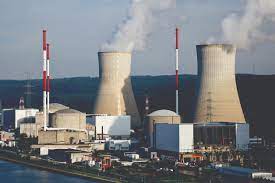Welcome to the adventurous and dramatic world of mechanical engineering. Today we are going to discuss about Types and Working of cooling tower. So, stay tuned till end to learn each and every aspect of cooling tower.
What is a Cooling Tower?
Table of Contents
A cooling tower is a heat removal device that uses water to pass a process, dissipating heat in the atmosphere. Similarly, an industrial cooling tower operates by removing the heat from the water by evaporating a small portion of the water and circulating the unit.
Mixing warm water with cool air releases a subtle evaporating heat, which causes the water to cool. If you look down from a high-rise building, you may see square units with fans above them in the buildings below. Those are water cooling towers.
How Does the Cooling Tower Work?
Hot water comes to the entrance of the tower and is pumped up to the top of the head. The header contains pipes and sprays used for spraying water, and will increase the surface area of the water.
After that, the water came to fill the PVC; it used to slow down the flow of water. On top of the cooling tower, fans are used to lift the air from the bottom to the top.
Due to the slow speed and the contact area of the water, it makes good contact between air and hot water. This process will reduce the water temperature through evaporation and cooling water is collected at the bottom of the cooling tower, and this cooled water is used and boiled.
Different Parts Cooling Tower
- Eliminator: It is not allowed to pass water. The Eliminator is mounted on the top of the tower, where only hot air can pass.
- Spray Nozzles and Header: These components are used to increase evaporation by increasing the surface area of the water.
- PVC Falling: Reduces the falling speed of hot water and looks like a beehive.
- Mesh: When the fan is ON, it uses the atmosphere to contain unwanted dust particles. Mesh is used to stop these particles and does not allow dust to enter the cooling tower.
- Float Valve: Used to maintain water level.
- Bleed Valve: Used to control the mixing of minerals and salts.
- Body: The body or outer surface of the cooling tower is usually made of FRP (fiber reinforced plastic), which protects the inner parts of the cooling tower.
Types of Cooling towers
Cooling towers can be divided into two types:
1) Natural Draught Cooling Tower:
In this type of cooling tower, the fan is not used to circulate the air but here, by closing the hot air in the chimney and will create a pressure difference between the hot air and the surrounding air.
As a result of this pressure difference the air enters the cooling tower. It requires a large hyperbolic tower, so capital costs are high but operating costs are low due to the lack of electrical furniture.
There are two types of natural draft cooling tower. One is rectangular wooden tower and other is reinforced concrete hyperbolic tower.
2) Mechanical or forced draught cooling tower:
In this type of cooling tower, a fan is used to circulate air. If the power station operates at high load, it requires a very high level of cooling water. To rotate the fan, it uses an engine with a speed of about 1000 rpm.
The principle of operation is similar to a natural draught cooling tower. But the only difference being that here the fan is mounted on a cooling tower.
When the fan is mounted on top of the tower it is called a induced draught cooling tower that is very popular for large volume installation and requires a large fan capacity.
Therefore, a compulsory draft cooling tower consists of a horizontal fan shaft and is placed at the bottom of the tower and a draft refurbished cooling tower contains a straight shaft and is mounted on top of the cooling tower.
That’s it from today’s article. Hope you all like this information. For more mechanical engineering stuffs like this stay tuned with us. Also do follow us in our social media platforms.
